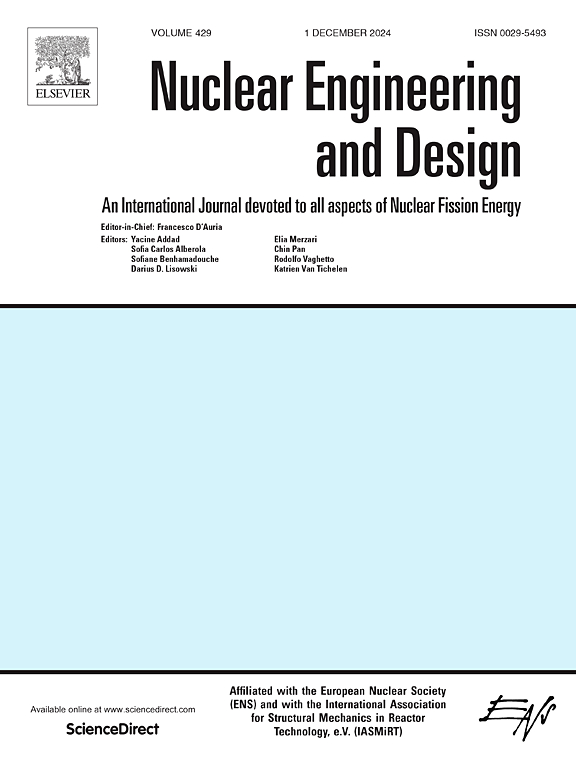Design and performance assessment of air cooling channel for passive containment cooling system water tank in HPR1000
IF 2.1
3区 工程技术
Q1 NUCLEAR SCIENCE & TECHNOLOGY
引用次数: 0
Abstract
The Passive Containment Cooling System (PCCS) is one of the passive safety systems in HPR1000. Its maximum continuous operating time depends entirely on the running time of the external containment water tank. Hence, removing the heat from the tank and prolonging the water tank’s operating time are undoubtedly the keys to the problem. In this study, adding air cooling channels on the outside of the water tank has been modeled using numerical simulations to investigate the characteristics of a passive mechanism of shutdown heat removal. A basic channel is selected to verify the feasibility of prolonging the PCCS maximum continuous operating time and explore the air cooling channel’s maximum capacity to remove heat from core decay from three aspects: the emissivity of the surface materials, channel spacing, and chimney height. Due to the uncertainty of the turbulence model and the geometry simplification, ten independent reliable calculations under identical conditions demonstrate that an optimal air cooling channel geometry design could prolong the maximum continuous operating time of the PCCS up to the order of 116–120 h, which is substantially higher than 72 h of the reference case. Furthermore, the selection of surface materials with a high emissivity and increasing chimney height would be crucial measures in safety design. This study provides future researchers with a guideline for designing passive safety measures for advanced reactors.
HPR1000被动安全壳冷却系统水箱风冷道设计及性能评价
被动式安全壳冷却系统(PCCS)是HPR1000的被动式安全系统之一。其最大连续运行时间完全取决于外容水箱的运行时间。因此,将水箱散热,延长水箱运行时间无疑是解决问题的关键。在本研究中,采用数值模拟的方法对水箱外部增加风冷通道进行了建模,研究了被动停堆散热机制的特性。选择一个基本通道,从表面材料的发射率、通道间距、烟囱高度三个方面验证延长PCCS最大连续运行时间的可行性,探索风冷通道最大排热能力。由于湍流模型的不确定性和几何结构的简化,在相同条件下进行的10次独立可靠计算表明,优化的风冷通道几何设计可以将PCCS的最大连续工作时间延长至116-120 h,大大高于参考情况的72 h。此外,选择高发射率的表面材料和增加烟囱高度将是安全设计的关键措施。该研究为今后研究人员设计先进反应堆的被动安全措施提供了指导。
本文章由计算机程序翻译,如有差异,请以英文原文为准。
求助全文
约1分钟内获得全文
求助全文
来源期刊

Nuclear Engineering and Design
工程技术-核科学技术
CiteScore
3.40
自引率
11.80%
发文量
377
审稿时长
5 months
期刊介绍:
Nuclear Engineering and Design covers the wide range of disciplines involved in the engineering, design, safety and construction of nuclear fission reactors. The Editors welcome papers both on applied and innovative aspects and developments in nuclear science and technology.
Fundamentals of Reactor Design include:
• Thermal-Hydraulics and Core Physics
• Safety Analysis, Risk Assessment (PSA)
• Structural and Mechanical Engineering
• Materials Science
• Fuel Behavior and Design
• Structural Plant Design
• Engineering of Reactor Components
• Experiments
Aspects beyond fundamentals of Reactor Design covered:
• Accident Mitigation Measures
• Reactor Control Systems
• Licensing Issues
• Safeguard Engineering
• Economy of Plants
• Reprocessing / Waste Disposal
• Applications of Nuclear Energy
• Maintenance
• Decommissioning
Papers on new reactor ideas and developments (Generation IV reactors) such as inherently safe modular HTRs, High Performance LWRs/HWRs and LMFBs/GFR will be considered; Actinide Burners, Accelerator Driven Systems, Energy Amplifiers and other special designs of power and research reactors and their applications are also encouraged.
 求助内容:
求助内容: 应助结果提醒方式:
应助结果提醒方式:


